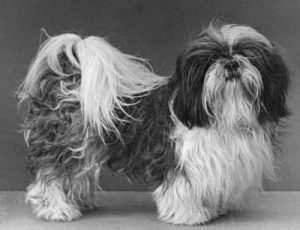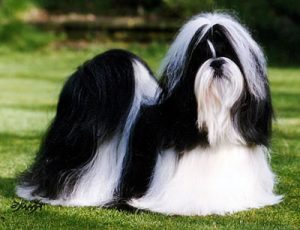Health
A centuries old breed from a geographically diverse foundation, the Shih Tzu has remained relatively unchanged since it was first introduced into the Western World in the 1930’s. The founding dogs were not related so the genetic basis for the development of the breed in the United Kingdom was diverse from the onset. The genetic variance was further increased by the Peke-cross of 1952.
The only real change that has occurred within the breed is that of a cosmetic one, namely the hair as grooming techniques and products improved over time. Whether grown out or clipped off, the hair does not impede a dogs day-to-day life. Contrary to belief, the long hair is infact insulating.
Generally speaking the Shih Tzu is a healthy and very long lived breed (14 – 18 years is common). To ensure this is it paramount you acquire your puppy from an ANKC registered breeder.
Brachycephalic Obstructive Airway Syndrome (BOAS)
The term ‘brachycephalic’ relates to the skull. A brachycephalic skull is relatively broad and short. The ratio varies between brachycephalic breeds.
The respiratory disease related to brachycephalic conformation is called brachycephalic obstructive airway syndrome (BOAS). Fact is not all brachycephalic breeds are affected by BOAS.
The Shih Tzu is NOT on the BOAS watchlist of breeds.
Of note the Shih Tzu is not a traditional ‘face-faced’ breed per se having a nose length of one inch.
Obesity is also a major contributor to breathing issues.
A recent study led by the Roslin Institute at the University of Edinburgh’s Royal School of Veterinary Studies has found that a DNA mutation in a gene called ADAMTS3 that is not dependent on skull shape is linked to upper airway syndrome in Norwich Terriers and is also common in French and English bulldogs. This is yet another indication that at least some of what is being called brachycephalic airway syndrome is a complex condition that is not dependant on skull shape alone.
For more information click here.

Photo Circa. 1950

Photo Circa. 2000’s
Common Questions
Are Shih Tzu prone to eye injuries?
Whilst their eyes are large, Shih Tzu are no more prone to eye injuries than and other dog.
Most eye injuries can be very successfully treated, the quicker veterinary help is sought the better the chances of a full recovery. A daily check of your dogs eyes, accompanied by a quick wipe to keep them clear of any build up, is usually sufficient to spot anything untoward and to allow prompt treatment. After an injury the affected eye often starts to take on a bluish tint. It isn’t always possible to see the injury itself immediately. When an eye has an infection, such as conjunctivitis, it will often appear inflamed and you may notice more blinking or winking. Eye injuries and infections can be very painful and you should seek veterinary help as soon as you can.
How often should I bath my dog?
The simple answer is ‘when he’s dirty’. Every week or two is fine. More important than how often are the products you use.
Should I worry about a hernia?
There are a number of different type of hernia that can occur in dogs, namely umbilical and inguinal hernias.
A hernia should always be pointed out to you and discussed by a responsible breeder when choosing a puppy.
Umbilical hernias are not uncommon in Shih Tzu. A Shih Tzu with an umbilical hernia will have a tiny bulge in the middle of the tummy, where the umbilical cord was attached, caused by an incompletely closed umbilical ring. The majority of umbilical hernias are believed to be caused by the umbilical cord being severed too close to the abdominal wall at birth. Most umbilical hernias are small and will get smaller or even disappear completely by the time a puppy is several months old. Umbilical hernias rarely require surgical intervention and do not affect a dogs quality of life. Often it is convenient to have them removed at the time of being de-sexed.
My dogs ears smell?
Shih Tzu are no more prone than any other dog to have ear infections. They do, however, grow hair inside their ears which needs to be removed periodically to help keep the ears clean. The most common problem is ear mites. They are usually picked up from direct contact with another dog. They make your dogs ears itch and secrete a brown waxy substance. Veterinary treatment is simple but should be sought quickly as the longer an infestation is untreated the greater the likelihood of secondary complications such as infections. Check your dogs ears regularly to make sure they are clean.
My puppys nose has tightened?
Many Shih Tzu puppies’ nostrils will tighten when they are teething, they sound snuffly and they may blow the odd clear bubbles from their nose. This is completely normal and is due to the swelling involved with cutting new teeth. They grow out of it when their adult teeth finish coming though, usually by around 6 months of age.
